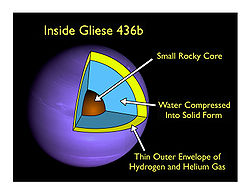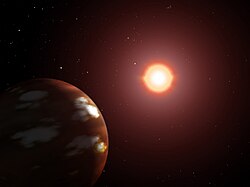Gliese 436 b
Template:Planetbox begin Template:Planetbox image Template:Planetbox star Template:Planetbox orbit Template:Planetbox character Template:Planetbox discovery Template:Planetbox reference Template:Planetbox end
Gliese 436 b (Template:Pron-en), or GJ 436 b,[1] is a Neptune-sized extrasolar planet orbiting the red dwarf star Gliese 436.[2] As of February 2009, it remains the second smallest transiting planet in mass and radius, after COROT-7b.
Discovery
Gliese 436 b was discovered in August 2004 by R. Paul Butler and Geoffrey Marcy of the Carnegie Institute of Washington and University of California, Berkeley, respectively, using the radial velocity method. Together with 55 Cancri e, it was then the first of a new class of planets with a minimum mass (M sini) similar to Neptune.
The planet was recorded to transit its star by an automatic process at NMSU on January 11, 2005, but this event went unheeded at the time.[3] In 2007, Gillon led a team which observed the transit, grazing the stellar disc relative to Earth. Transit observations led to the determination of Gliese 436 b's exact mass and radius, both of which are very similar to Neptune. Gliese 436 b then became the smallest known transiting extrasolar planet. The planet is about 4000 km larger in diameter than Uranus and 5000 km larger than Neptune and a bit more massive. Gliese 436b (also known as GJ 436b) orbits its star at a distance of 4,000,000 km or 15 times closer than Mercury's average distance from the sun.
Physical characteristics

One orbit around the star takes only about 2 days, 15.5 hours. The planet's surface temperature is estimated from measurements taken as it passes behind the star to be 712 K (439 °C).[4] This temperature is significantly higher than would be expected if the planet were only heated by radiation from its star (which had been, in a Reuters article from a month prior to this measurement, estimated at 520 K). Whatever energy that tidal effects deliver to the planet does not notably affect its temperature.[5] Its discoverers allowed for a temperature increase due to a greenhouse effect.[6]
Its main constituent was initially predicted to be hot "ice" in various exotic high-pressure forms,[6][7] which remains solid because of the planet's gravity despite the high temperatures.[8] The planet could have formed further from its current position, as a gas giant, and migrated inwards with the other gas giants. As it arrived in range, the star would have blown off the planet's hydrogen layer via coronal mass ejection.[9]
However when the radius became better known, ice alone was not enough to account for it. An outer layer of hydrogen and helium up to ten percent in mass would be needed on top of the ice to account for the observed planetary radius.[4][10] This obviates the need for an ice core. Alternatively, the planet may be a super-earth.[11]
Kevin Stevenson of UCF et al. observed the secondary transit under the Spitzer Exoplanet Target of Opportunity program in January and February 2008. On Saturday 11 October 2008, 9:30 – 9:40 am, these results will be presented.[12]
Kevin Stevenson of UCF et al. have recently reported in Nature about a possible thermochemical disequilibrium in the atmosphere of this exoplanet. Results published in Nature suggest that Gliese 436b's atmosphere is abundant in CO and deficient in methane (CH4) by a factor of ~7,000. This result is unexpected because, based on current models at this temperature, the atmospheric carbon should prefer CH4 over CO.[13] [14]
Orbital characteristics
This planet should not be as eccentric as is measured. To have maintained its eccentricity over time requires that it be accompanied by another planet.[4][15] In September 2008, a formerly-unrecognised transit signature at NMSU from January 11 2005 was incorporated into the data up to then, consistent with a planet at 0.08 AU and under 12 Earth masses.[3]
References
- ^ Maness; et al. (2006). "The M Dwarf GJ 436 and its Neptune-Mass Planet". Submitted to Publications of the Astronomical Society of the Pacific.
{{cite journal}}: Explicit use of et al. in:|author=(help) - ^ Butler; Vogt, Steven S.; Marcy, Geoffrey W.; Fischer, Debra A.; Wright, Jason T.; Henry, Gregory W.; Laughlin, Greg; Lissauer, Jack J.; et al. (2004). "A Neptune-Mass Planet Orbiting the Nearby M Dwarf GJ 436". The Astrophysical Journal. 617: 580–588. doi:10.1086/425173.
{{cite journal}}: Explicit use of et al. in:|author=(help) - ^ a b Coughlin, Jeffrey L.; Stringfellow, Guy S.; Becker, Andrew C.; Mercedes Lopez-Morales; Fabio Mezzalira; Tom Krajci (2008). "New observations and a possible detection of parameter variations in the transits of Gliese 436b". arXiv:0809.1664v1 [astro-ph].
- ^ a b c Drake Deming; Joseph Harrington; Gregory Laughlin; Sara Seager; Navarro, Sarah B.; Bowman, William C.; Karen Horning (2007). "Spitzer Transit and Secondary Eclipse Photometry of GJ 436b". arXiv:0707.2778 [astro-ph].
- ^ Brian Jackson; Richard Greenberg; Rory Barnes (2008). "Tidal Heating of Extra-Solar Planets". arXiv:0803.0026v1 [astro-ph].
- ^ a b M. Gillon; et al. (2007). "Detection of transits of the nearby hot Neptune GJ 436 b" (PDF). Astronomy and Astrophysics. 472 2: L13-L16.
{{cite journal}}: Explicit use of et al. in:|author=(help) - ^ Shiga, David (6 May 2007). "Strange alien world made of "hot ice"". New Scientist. Retrieved 2007-05-16.
- ^ Fox, Maggie (May 16, 2007). "Hot "ice" may cover recently discovered planet". Science News. Scientific American.com. Retrieved 2008-08-06.
- ^ H. Lammer; et al. (2007). "The impact of nonthermal loss processes on planet masses from Neptunes to Jupiters" (PDF). Geophysical Research Abstracts. 9 (07850).
{{cite journal}}: Explicit use of et al. in:|author=(help) By analogy with Gliese 876 d. - ^ Bean, J.L.; et al. (2008). "A Hubble Space Telescope transit light curve for GJ 436b". Astronomy & Astrophysics.
{{cite journal}}: Explicit use of et al. in:|author=(help) - ^ E. R. Adams, S. Seager, and L. Elkins-Tanton (2008). "Ocean Planet or Thick Atmosphere: On the Mass-Radius Relationship for Solid Exoplanets with Massive Atmospheres". The Astrophysical Journal. 673 (2): 1160–1164. doi:10.1086/524925.
{{cite journal}}: Unknown parameter|month=ignored (help)CS1 maint: multiple names: authors list (link) - ^ Secondary Eclipse Photometry of GJ 436b in Six Spitzer Channels BAAS , 40, no 3 , 01.07
- ^ Possible thermochemical disequilibrium in the atmosphere of the exoplanet GJ 436b Nature 464, 1161-1164 (22 April 2010)
- ^ GJ436b - Where's the methane? Planetary Sciences Group at the University of Central Florida, Orlando
- ^ Bean, Jacob L.; Andreas Seifahrt (2008). "Observational Consequences of the Recently Proposed Super-Earth Orbiting GJ436". arXiv:0806.3270v2 [astro-ph].
Selected media articles
- How Do Artists Portray Exoplanets They've Never Seen? 4/9, Scientific American October 2, 2007.
- Astronomers Detect Shadow Of Water World In Front Of Nearby Star (from Science Daily).
See also
External links
![]() Media related to Gliese 436 b at Wikimedia Commons
Media related to Gliese 436 b at Wikimedia Commons

